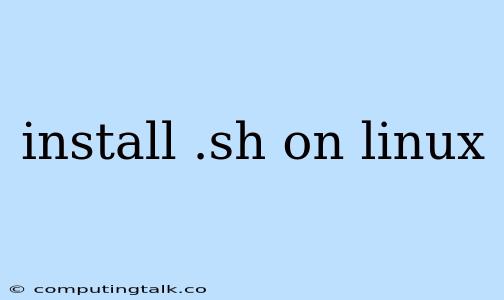Installing a .sh file on Linux is a common task for many users. These files contain shell scripts, which are sequences of commands that can automate various tasks. This article will guide you through the process of installing a .sh file on your Linux system, covering essential aspects such as permissions, execution, and potential issues you might encounter.
Understanding .sh Files
A .sh file, short for shell script, is a plain text file containing a series of commands that can be executed by a shell interpreter like bash. These scripts can perform various actions, such as installing software, configuring settings, or automating repetitive tasks.
Installing a .sh File
Installing a .sh file on Linux typically involves the following steps:
-
Downloading the file: Obtain the
.shfile from a trusted source. This can be done through a web browser or by using a command-line tool likewgetorcurl. -
Checking permissions: Before running a shell script, ensure it has execute permissions. Use the following command in your terminal to check the permissions:
ls -l filename.shIf the file permissions do not include "x" (execute), you'll need to grant execute permissions.
-
Granting execute permissions: Use the
chmodcommand to modify permissions. For example:chmod +x filename.shThis command adds execute permissions to the file.
-
Running the script: Execute the script by typing the following in your terminal:
./filename.shThis will start the script and run the commands contained within it.
Important Note: Always ensure the .sh file originates from a reputable source and understand its purpose before executing it. Malicious scripts can potentially harm your system.
Potential Issues and Solutions
While installing .sh files is generally straightforward, you may encounter issues. Here are some common problems and how to address them:
1. Permission Errors:
- Error message: "Permission denied."
- Solution: Verify that you have execute permissions for the file. Use
chmod +x filename.shto grant execute permissions.
2. Missing Dependencies:
- Error message: The script might fail to execute due to missing packages or libraries.
- Solution: The script may indicate the necessary dependencies. Install them using your Linux package manager (e.g., apt, yum, dnf).
3. Syntax Errors:
- Error message: "Syntax error near unexpected token..."
- Solution: The script may contain syntax errors. Carefully review the script for typos or incorrect command usage.
4. Script Execution Environment:
- Error message: The script might not function correctly in your specific environment.
- Solution: The script may require certain environment variables or specific configurations. Ensure that these requirements are met in your system.
5. Security Concerns:
- Error message: You might receive warnings about potentially insecure actions.
- Solution: Always be cautious when running scripts from unknown sources. Review the script's code before executing it.
Tips for Working with .sh Files
- Use a text editor: Use a text editor like
nanoorvimto view and edit shell scripts. - Check the shebang line: The first line of a shell script typically starts with
#!/bin/bash. This line specifies the shell interpreter to be used. - Comment your code: Use comments to explain the purpose of each section of your script.
- Use debugging tools: Utilize debugging tools like
bash -xto trace the execution of your script. - Test your scripts: Always test your scripts in a safe environment before running them on your production system.
- Learn about shell scripting: Explore resources and tutorials to enhance your understanding of shell scripting.
Conclusion
Installing .sh files on Linux is a common and useful practice. By following the steps outlined in this article and being aware of potential issues, you can confidently install and execute these scripts to automate tasks, install software, and enhance your system's functionality. Remember to always exercise caution when executing scripts from untrusted sources and prioritize the security of your system.
